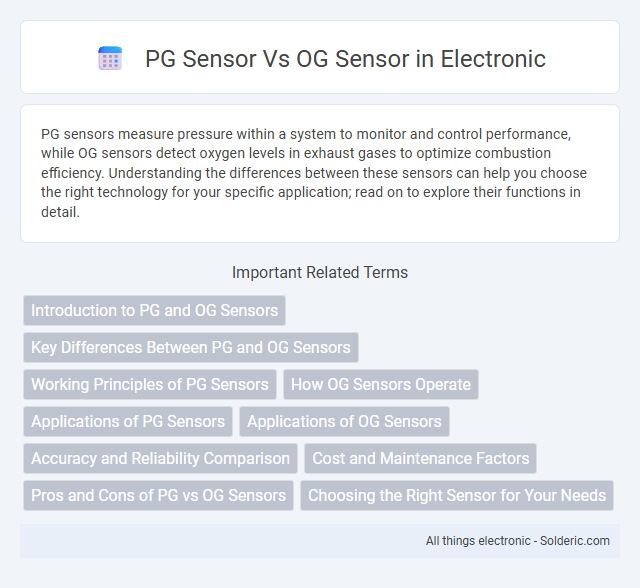PG sensors measure pressure within a system to monitor and control performance, while OG sensors detect oxygen levels in exhaust gases to optimize combustion efficiency. Understanding the differences between these sensors can help you choose the right technology for your specific application; read on to explore their functions in detail.
Comparison Table
| Feature | PG Sensor | OG Sensor |
|---|---|---|
| Full Name | PhotoGate Sensor | OptoGate Sensor |
| Technology | Photointerrupter with infrared LED and phototransistor | Optical sensor using light emission and detection |
| Sensitivity | Moderate sensitivity, suitable for general object detection | High sensitivity with precise object presence detection |
| Typical Applications | Position sensing, encoder wheel detection | Object counting, position monitoring in automation |
| Response Time | Fast response time (microseconds) | Very fast response time (nanoseconds) |
| Operating Distance | Short range, a few millimeters | Variable range, up to several centimeters |
| Output Type | Digital (on/off signal) | Digital or analog depending on model |
| Cost | Lower cost, widely available | Higher cost due to precision and features |
Introduction to PG and OG Sensors
PG sensors, or pressure gradient sensors, measure changes in pressure over a specific distance, providing accurate data for applications like fluid dynamics and environmental monitoring. OG sensors, or optical gas sensors, detect and quantify gas concentrations using light absorption or emission properties, commonly used in air quality and industrial safety. Your choice between PG and OG sensors depends on whether you need precise pressure measurement or gas detection capabilities.
Key Differences Between PG and OG Sensors
PG sensors primarily measure pressure changes using piezoelectric materials, offering high sensitivity and fast response times ideal for dynamic pressure monitoring. OG sensors, based on optical principles, detect environmental changes through light modulation, providing excellent accuracy and immunity to electromagnetic interference. Key differences include operating mechanisms, sensitivity to environmental factors, and application suitability, with PG sensors favored for mechanical systems and OG sensors preferred in noise-prone or hazardous environments.
Working Principles of PG Sensors
PG sensors operate based on piezoelectric principles, generating an electric charge in response to mechanical stress or pressure changes. These sensors convert pressure fluctuations into electrical signals that can be precisely measured, providing accurate and real-time data. Your choice of PG sensor ensures reliable performance in applications requiring sensitive pressure detection and rapid response times.
How OG Sensors Operate
OG sensors operate by detecting unburned hydrocarbons in the exhaust gas using a heated zirconia element that generates a voltage signal when oxygen levels change, which helps regulate the air-fuel ratio for optimal combustion. Unlike PG sensors that measure partial pressure of gases, OG sensors provide direct feedback to the engine control unit for precise fuel mixture adjustments, enhancing engine efficiency and reducing emissions. Your vehicle relies on this real-time oxygen measurement to maintain optimal performance and meet emission standards.
Applications of PG Sensors
PG sensors excel in applications requiring precise measurement of pressure and gas concentrations, such as industrial automation, HVAC systems, and environmental monitoring. These sensors provide high sensitivity and rapid response times, making them ideal for ensuring safety and efficiency in manufacturing processes and air quality assessment. Your choice of a PG sensor enables reliable data collection critical for optimizing system performance and maintaining regulatory compliance.
Applications of OG Sensors
OG sensors are widely used in automotive exhaust systems to monitor oxygen levels, ensuring optimal combustion and reduced emissions. These sensors play a critical role in engine management systems by providing real-time data to adjust the air-fuel mixture for improved fuel efficiency and lower pollutant output. Your vehicle's performance and environmental compliance heavily rely on the accurate functioning of OG sensors.
Accuracy and Reliability Comparison
PG sensors generally offer higher accuracy due to their advanced signal processing capabilities, ensuring precise data capture even in complex environments. OG sensors tend to be less reliable in fluctuating conditions, as their simpler design can lead to signal interference and inconsistent readings. When considering sensor options, your choice depends on whether maximum accuracy or cost-efficiency is the priority for your application.
Cost and Maintenance Factors
PG sensors typically incur higher upfront costs than OG sensors due to advanced materials and technology integration. Maintenance for PG sensors often requires specialized calibration and is more frequent because of their sensitivity, raising long-term expenses. OG sensors offer a cost-effective alternative with lower purchase prices and simpler maintenance routines, reducing overall operational costs.
Pros and Cons of PG vs OG Sensors
PG sensors offer high sensitivity and quick response times, making them ideal for detecting precise changes in pressure or gas levels, but they can be more expensive and require careful calibration. OG sensors provide robust performance and durability in harsh environments with lower costs, though they may have slower response times and less accuracy compared to PG sensors. Your choice depends on the specific application requirements, balancing accuracy, cost, and environmental conditions.
Choosing the Right Sensor for Your Needs
Choosing the right sensor depends on your specific application, as PG sensors offer precise piezoelectric pressure measurement ideal for dynamic pressure changes, while OG sensors utilize optical technology for high sensitivity and immunity to electromagnetic interference. PG sensors excel in environments requiring fast response and durability, whereas OG sensors are preferred for applications demanding high accuracy and stability over long distances or in harsh conditions. Understanding the operational environment and performance criteria ensures you select the sensor that best aligns with your measurement needs.
PG sensor vs OG sensor Infographic

 solderic.com
solderic.com